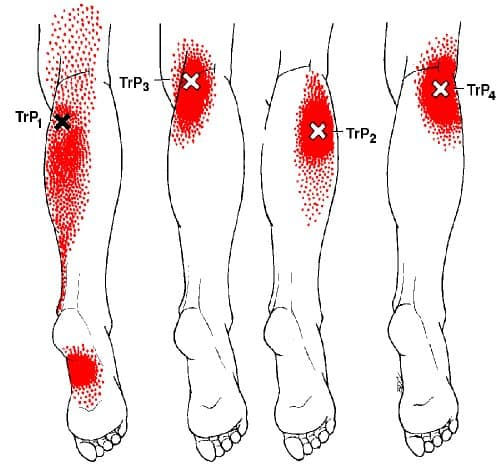If you’re struggling with heel pain from plantar fasciitis, the solution might not be in your foot—it could be hiding in your calf. While most people treat the plantar fascia directly, few realize that tight calf muscles can create pain patterns that mimic or worsen plantar fasciitis symptoms.
In this guide, we’ll break down how trigger points in the calf, especially in the gastrocnemius and soleus muscles, are a key but often overlooked factor. We’ll also share how targeting the right plantar fasciitis massage points and calf pressure points can bring lasting relief.
Why Calf Pain and Plantar Fasciitis Are Closely Connected
Calf pain and plantar fasciitis are more connected than most people think. The gastrocnemius and soleus, your primary calf muscles, both attach to the Achilles tendon, which connects directly to the heel. When these muscles are tight or harbor trigger points, they increase the tension on the plantar fascia—leading to or worsening heel pain.
Even if the pain feels like it’s coming from your foot, it may be a referred sensation from higher up in the leg—specifically, from a plantar fasciitis trigger point in the calf.
Heel Pain Trigger Points: How Calf Muscles Contribute
When you’re dealing with heel pain trigger points, the sensation often feels localized to the heel or arch. But in reality, active trigger points in the gastrocnemius and soleus can send pain signals downward into the foot.
Common Signs of Referred Heel Pain:
- Sharp pain when stepping out of bed
- Aching or cramping in the arch
- Discomfort when walking uphill or on stairs
- Pain that doesn’t respond to typical foot treatments
If you’ve experienced these, your body may be signaling a trigger point in the calf that’s feeding into your plantar fasciitis symptoms.
Understanding the Gastrocnemius: A Key Calf Pressure Point
The gastrocnemius is the larger, more superficial calf muscle—and a frequent source of tension.
Symptoms of Gastrocnemius Trigger Points:
- Heel pain that intensifies with standing or walking
- Pulling sensation up the back of the leg
- Tightness in the arch that doesn’t resolve with stretching
This muscle contains important calf pressure points that, when released, can dramatically reduce tension on the plantar fascia.
The Soleus Muscle: A Deep Driver of Heel Pain from Plantar Fasciitis
The soleus, located beneath the gastrocnemius, plays a huge role in chronic calf pain and plantar fasciitis. Unlike the gastrocnemius, the soleus is active during both walking and standing, and its trigger points frequently refer pain straight into the heel.
Watch for These Signs of Soleus Involvement:
- A dull ache in the heel after standing for long periods
- Difficulty flexing the foot
- Pain that persists even when at rest
Treating heel pain from plantar fasciitis without addressing the soleus can leave recovery incomplete.
Plantar Fasciitis Massage Points That Bring Relief
Effective relief often depends on targeting the right plantar fasciitis massage points—many of which are located in the calf.
Top Pressure Points for Plantar Fasciitis:
- Medial belly of the gastrocnemius
- Lower third of the soleus (just above the Achilles tendon)
- Junction of the Achilles tendon and heel
By applying manual pressure or using myofascial release techniques, these pressure points for plantar fasciitis can reduce pain, restore mobility, and reduce strain on the plantar fascia.
Why Treating the Calf is Essential for Heel Pain Relief
Ignoring calf pressure points while treating heel pain from plantar fasciitis is like fixing a leak without turning off the faucet. The tension from the calf muscles continues to pull on the plantar fascia, preventing real healing.
At Body Heal Therapy, our integrative approach includes:
- Identifying every plantar fasciitis trigger point in calf
- Releasing tight tissue and improving mobility
- Addressing movement patterns contributing to long-term strain
This whole-body approach helps relieve not just the foot, but the entire lower kinetic chain—improving function and reducing the chance of recurrence.
When to See a Specialist for Heel Pain Trigger Points
Wondering if calf trigger points are contributing to your plantar fasciitis?
You Should Seek Help If You Have:
- Persistent heel pain for more than two weeks
- Stiffness in both the foot and calf
- Pain when pressing into your Achilles tendon or calf
- Daily recurring morning pain
- Limited ankle mobility or foot flexion
These symptoms often point to deeper heel pain trigger points in the calf that need expert treatment.
Book Your Session at Body Heal Therapy
Don’t let untreated calf pressure points hold back your recovery. Addressing the true source of your heel pain can lead to better mobility, less daily discomfort, and longer-lasting results.Schedule your session today to target the calf trigger points that may be driving your plantar fasciitis pain—and finally experience the relief you’ve been searching for.




